Joshua Weissman is a popular social media chef and influencer famous for his culinary skills. His exceptional cooking prowess and knife mastery have made people wonder what knife he uses.
So, what knife does Joshua Weissman use?
The “Makoto Kurosaki Sakura Gyuto” is probably the knife he uses the most among other knives. Apart from this, he also uses different Japanese-originated knives, like the “Konosuke Sanjo”, “Ohishi Mikagi Tsuchime Petty” and the “Togiharu Molybdenum Gyuto”. Also, he has been seen using the “Tojiro ITK Bread Knife” and the “Hinoura Ajikataya Shirogami 2 Kurouchi Gyuto” for different purposes.
We will uncover all about his precious knife collection in the later parts of this article.
What Knife Does Joshua Weissman Use?
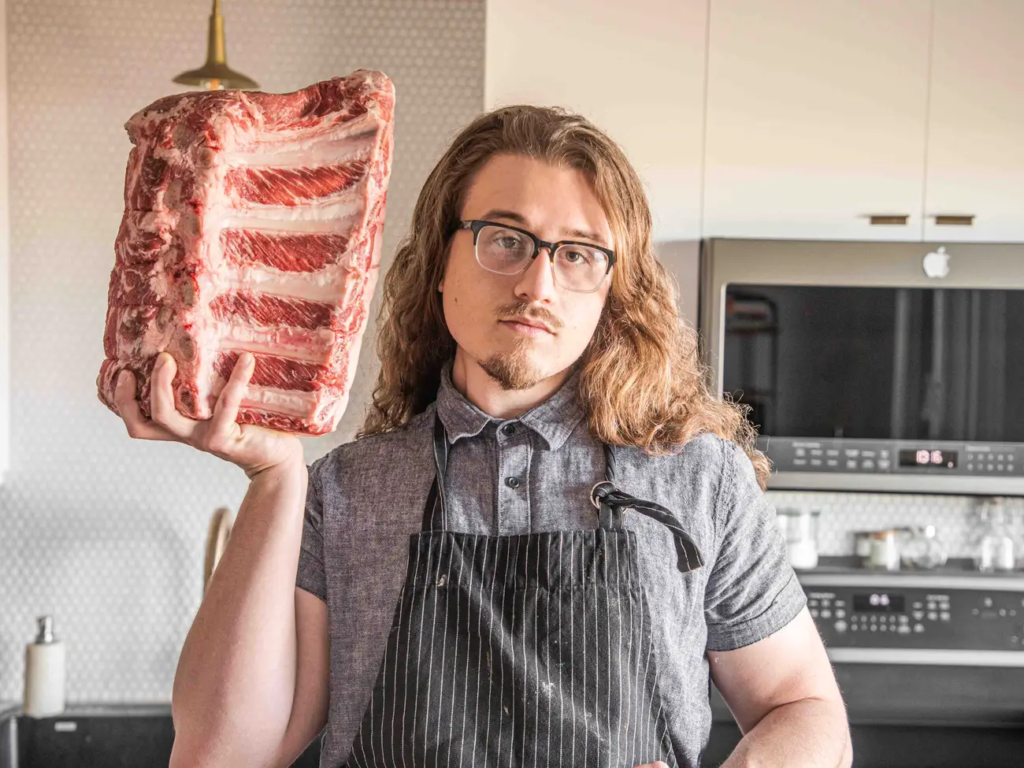
It should be obvious that Joshua Weissman has more than one knife. He has a thing for Japanese knives, most of the knives he uses have originated in Japan.
He has used multiple knives in his videos over time. He posted about the “Hinoura Ajikataya Shirogami 2 Kurouchi Gyuto” on his Facebook a couple of years back.

Currently, he uses the “240mm Makoto Kurosaki Sakura Gyuto SG2” in most of his videos, along with some other ones.
These are only some of the knives in Joshua Weissman’s collection. Other than these, he may also own a great set of steak knives or other types of knives.
| Knives | Key Feature |
| 240mm Konosuke Sanjo Khii Enju Handle | A super sharp knife great for all-around use |
| 210mm Togiharu Molybdenum Gyuto | All-around knife at an affordable price |
| 240mm Makoto Kurosaki Sakura Gyuto SG2 | Lightweight knife with a thin edge, extremely sharp and precise for slicing. |
| 135mm Ohishi Mikagi Tsuchime Petty SLD | Ideal for delicate food preparation, due to its slim profile and fine tip. |
| 270mm Tojiro ITK Bread Knife | Serrated bread knife for hard crusts |
| 270mm Hinoura Ajikataya Shirogami 2 Kurouchi Gyuto | Consistent grinds, easy to use and take care of |
240mm Konosuke Sanjo Khii Enju Handle:
The 240mm Konosuke Sanjo Khii Enju Handle is a beautifully crafted knife that has been meticulously finished by professionals. It’s no wonder why this Konosuke knife is one of the most favorite knives of Joshua Weissman.
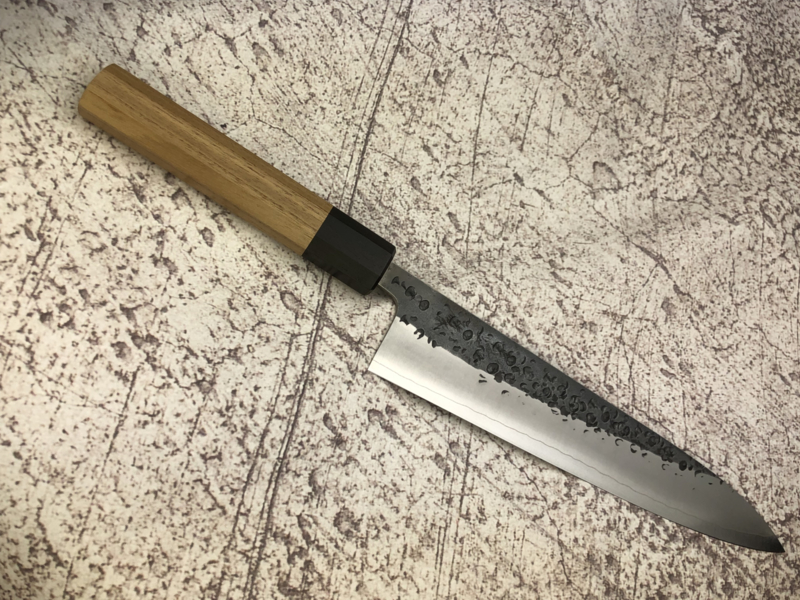
Let’s take a closer look at the specs of this knife-
| Feature | Specification |
| Blade length | 240 mm |
| Total length | 390 mm |
| Weight | 164 grams |
| Blade thickness | 3.1 mm (Measured where blade enters handle) |
| Blade height | 48 mm |
| Steel type | Japanese YS steel (semi-stainless), Sanmai Forged |
| Hardness | 63-64 (Rockwell C) |
| Handle | Octagonal handle from enju and maguro wood by Studio Khii. |
| Cover | Handmade Magnolia wooden cover (saya) |
Double-sided Ground Blade:
The blade of this knife has been expertly ground on both sides, making it suitable for both left and right-handed use. It features a core of semi-stainless Japanese YS steel, comparable in hardness to SG2 steel. This core is sandwiched between the softer stainless cladding and has a hammered blacksmith finish.
Octagonal Handle:
The handle of the Konosuke Sanjo Khii Enju Handle knife is octagonal in shape, providing a comfortable and secure grip. It’s made from enju and maguro wood by the renowned Studio Khii and is suitable for both left and right-handed use.
Limited Edition:
As with all Konosuke knives, the Sanjo Khii Enju Handle knife is available in a very limited edition. The blades are produced in small batches, and the polishing and grinding are done by professionals working exclusively for Konosuke.
210mm Togiharu Molybdenum Gyuto:
The 210mm Togiharu Molybdenum Gyuto is a Japanese kitchen knife that’s perfect for everyday use. With its stain-resistant steel blade and comfortable POM handle, this knife is designed to handle a wide range of kitchen tasks with ease. Joshua Weissman labeled it as the best regular-use knife at an affordable price.
| Feature | Specification |
| Steel Type | Stain-Resistant Steel |
| Steel Material | AUS-10 |
| Knife Bevel | 70/30 |
| Handle Material | POM (Polyacetal Resin) |
| HRC | 59 |
| Knife Weight | 180 grams |
| Blade Width | 1.8 inches (Widest part of the blade) |
| Spine Width | 0.06 inches (Widest part of the spine) |
| Handle Length | 4.5 inches |
High-Quality Blade Material:
The Togiharu Molybdenum Gyuto is made from AUS-10 stain-resistant steel. This type of steel is known for its excellent edge retention and durability. It’s a popular choice for Japanese knives because it’s easy to sharpen and maintain.
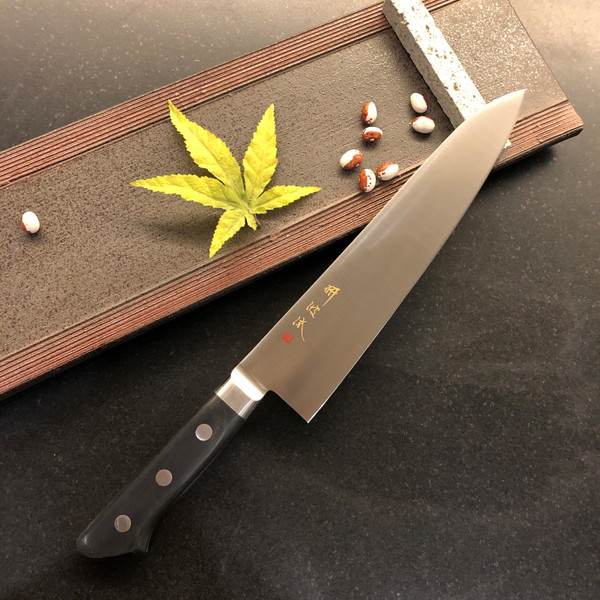
Designed for Efficiency:
The blade of this knife has a classic Gyuto shape, which is designed for slicing, dicing, and chopping. It features a 70/30 bevel, which means that the blade is ground more on one side than the other providing sharper edge.
Comfortable Handle:
The handle of the Togiharu Molybdenum Gyuto is made from POM (Polyacetal Resin). This material is known for its durability and resistance to heat and moisture. It provides a comfortable and secure grip, even when the handle is wet.
Lightweight:
At 180 grams, the Togiharu Molybdenum Gyuto is a lightweight knife that is easy to handle. The blade is 210mm long, and the handle is 4.5 inches long. The blade width at its widest point is 1.8 inches, and the spine width at its widest point is 0.06 inches.
240mm Makoto Kurosaki Sakura Gyuto SG2:
The 240mm Makoto Kurosaki Sakura Gyuto SG2 is a stunning Japanese kitchen knife that boasts exceptional craftsmanship and top-notch materials. Let’s take a closer look at its features:
| Feature | Specification |
| Blade Length | 240 mm |
| Total Length | 400 mm |
| Blade Height | 50 mm |
| Weight | 5.4 ounces |
| Construction | San Mai |
| Method | Hammer Forged, Water Quenched |
| HRC | 62+- |
| Finish | Kasumi |
| Edge Steel | SG2 Powdered Stainless Steel |
| Cladding | Stainless Steel |
| Handle | Cherry Octagonal |
| Ferrule | Maple |
| Spine Thickness at Base | 1.9 mm |
| Edge Grind | Even |
Superior Blade:
The Makoto Kurosaki Sakura Gyuto SG2 features a san-mai sandwich construction, with a core of SG2 powdered metallurgical steel and soft stainless alloy cladding. The blade has been hammer forged and water quenched for added durability, resulting in an impressive Rockwell hardness rating of 62±.
The steel used to make the knife can make all the differences between a great knife and an ”okay” knife. Knowing your steel can be handy before making a purchase. 154cm and s35vn might be two good materials to look out for.
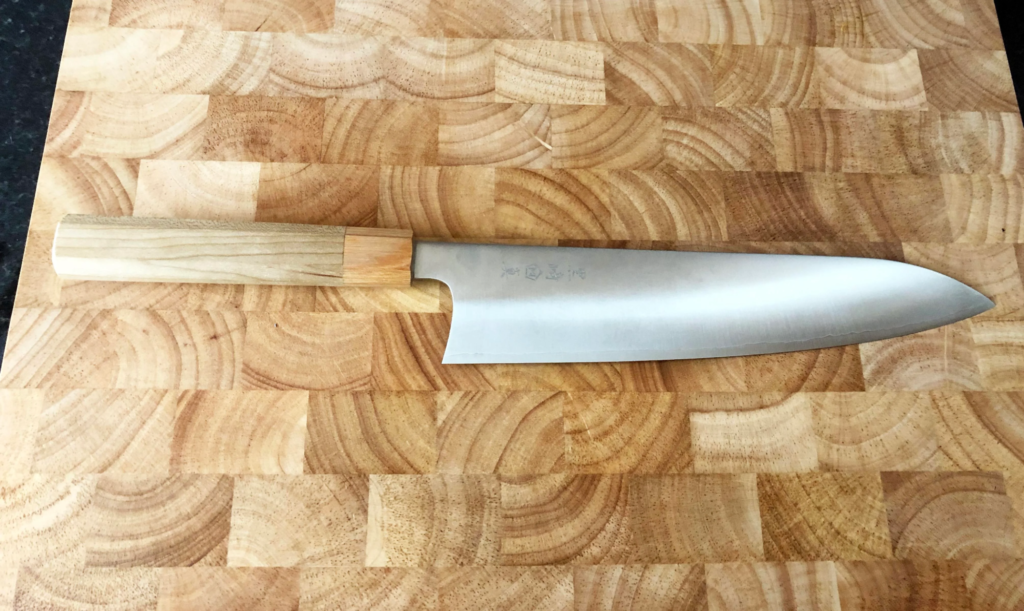
Traditional Japanese Construction:
The Makoto Kurosaki Sakura Gyuto SG2 is a high-quality knife that has been crafted using traditional Japanese techniques.
The knife features a kasumi finish, which adds to its visual appeal and helps to prevent food from sticking to the blade. Additionally, the even-edge grind is versatile and suitable for a wide range of cutting tasks, making it a great all-purpose knife in the kitchen.
Octagonal Handle:
The cherry handle of the Makoto Kurosaki Sakura Gyuto SG2 is not only visually stunning but also provides a comfortable grip for extended use. The octagonal shape of the handle allows for a secure and stable grip, even when wet. The ferrule, made of maple wood, adds a contrasting yet complementary touch to the handle’s design.
Lightweight:
At just 5.4 ounces, the Makoto Kurosaki Sakura Gyuto SG2 is a lightweight and agile knife, perfect for both professional chefs and home cooks. The total length of the knife is 400mm, making it comfortable for both large and small hands to use.
135mm Ohishi Mikagi Tsuchime Petty SLD:
The 135mm Ohishi Mikagi Tsuchime Petty SLD is a beautiful and functional kitchen knife that is perfect for delicate food preparation tasks. This knife can also be used as a boning knife, which is different from a butcher knife.
Let’s take a closer look at its features.
| Feature | Specification |
| Blade Material | SLD Steel |
| Blade Length | 135 mm |
| Overall Length | 270 mm |
| Blade Height | 31 mm |
| Spine Thickness | 3 mm (heel), 0.5 mm (tip) |
| Handle Material | Ebony (D-Shaped) |
| Weight | 88 gm |
| Finishing | Migaki-Tsuchime (Hammer tone) |
Hard and Sharp Blade:
The blade of this knife is made from SLD steel, which is known for its high performance and durability. It is hardened to HRC62-63, which means it can hold its sharp edge for a long time. The blade has a stainless steel cladding, which makes it easy to maintain and adds to its overall durability. The finishing of the blade is a Migaki-Tsuchime (hammer tone finish), which not only looks great but also helps to prevent food from sticking to the blade.
Easy to Use:
The blade of the Ohishi Mikagi Tsuchime Petty SLD is 135mm long, with an overall length of 270mm. It weighs 88gm, which makes it lightweight and easy to handle. The blade height at the heel is 31mm, with a spine thickness of 3mm at the heel and 0.5mm at the tip.
Double Bevel:
The knife has a double bevel, which means it is sharpened on both sides of the blade, making it suitable for both left and right-handed users. The handle is made from ebony and has a D-shape, which provides a comfortable and secure grip. The knife is designed for right-handed use.
270mm Tojiro ITK Bread Knife:
The Tojiro ITK Bread Knife is a high-quality Japanese kitchen knife designed to make slicing bread, pastries, and cakes an effortless task. Let’s take a closer look at some of its features:
| Specification | Details |
| Blade Material | Molybdenum Vanadium Steel |
| Blade Edge | Reverse Scalloped Edge |
| Blade Length | 270mm |
| Blade Angle | 9-12° |
| Handle Material | Pakkawood |
Blade Construction:
The blade is constructed using molybdenum vanadium steel, which is known for its superior hardness, durability, and corrosion resistance. This type of steel is especially important in a serrated blade, like this bread knife, because it helps the serrations stay sharp for the life of the knife without needing to be sharpened.
Blade Edge:
The Tojiro ITK Bread Knife has a reverse scalloped edge, which means that the serrations are facing toward the handle of the knife rather than toward the tip. This design helps to prevent tearing and crushing of the bread while also providing a clean and precise cut. The blade edge measures 270mm in length, making it long enough to easily slice through even the largest loaves of bread.
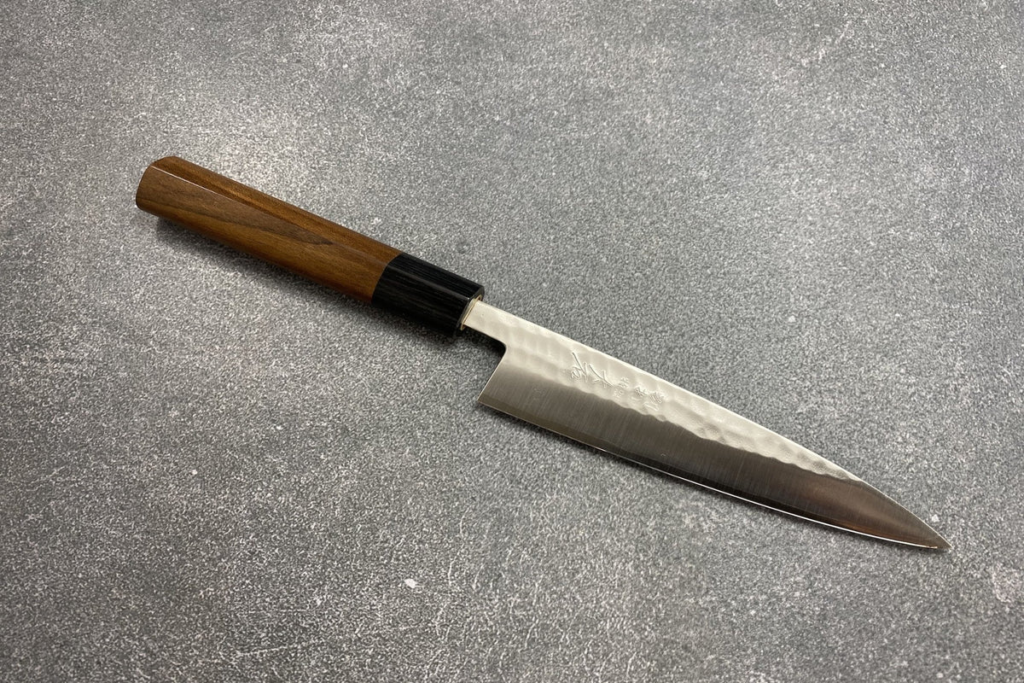
Blade Angle:
The blade has a single bevel with a 9-12° angle on one side, which allows for a clean and effortless cut through the bread. The other side of the blade is flat, providing stability and support while cutting.
Handle:
The Tojiro ITK Bread Knife features a triple riveted pakkawood handle, which is durable and resists deterioration over time. The handle provides a comfortable and secure grip, even when working with wet or slippery bread.
270mm Hinoura Ajikataya Shirogami 2 Kurouchi Gyuto:
The Hinoura Ajikataya Shirogami 2 Kurouchi Gyuto is a stunning example of traditional Japanese craftsmanship. Joshua Weisman posted a picture of this knife on his Facebook claiming his love for Japanese knives. Here are some of its key features:
| Feature | Specification |
| Blade length | 269mm |
| Spine thickness | 3.5mm |
| Height at heel | 53.1mm |
| Weight | 240g |
| Steel type | White #2 Carbon |
| Cladding | Iron |
| Finish | Kurouchi, Kasumi (Bevel) |
| Handle material | Magnolia wood and buffalo horn |
Sturdy Construction:
The blade is made from shirogami (white) #2 carbon steel and cladded in iron, giving it strength and durability. The kurouchi finish on the blade adds to its rustic and traditional look, while the kasumi finished bevels provide a polished contrast.

Perfect Size and Weight:
The blade is 269mm long and has a spine thickness of 3.5mm, making it a sturdy and substantial knife. The height at the heel is 53.1mm, giving you plenty of knuckle clearance. The knife weighs in at 240 grams, providing a good balance between heft and maneuverability.
Super Sharpness:
The blade is very sharp out of the box, thanks to the high-quality heat treatment that Hinoura is known for. The consistency of the grinds on this knife also makes it easy to maintain and sharpen. You should get yourself some chef knife covers to avoid any injuries.
The 10-Piece Universal Knife Guards from Noble home will give you that safety. Not only this knife but also other 9 sizes are there to keep your kitchen environment safer.
Comfortable Grip:
The knife comes with a high-quality oval magnolia and buffalo horn handle, which provides a comfortable and secure grip. The natural materials used in the handle construction are also aesthetically pleasing and add to the knife’s overall traditional look.
Where Does Joshua Weissman Buy His Knives From?
Joshua Weissman has revealed in his multiple videos that he loves to shop and sharpen knives from the “Bernal Cutlery” located in San Fransisco.
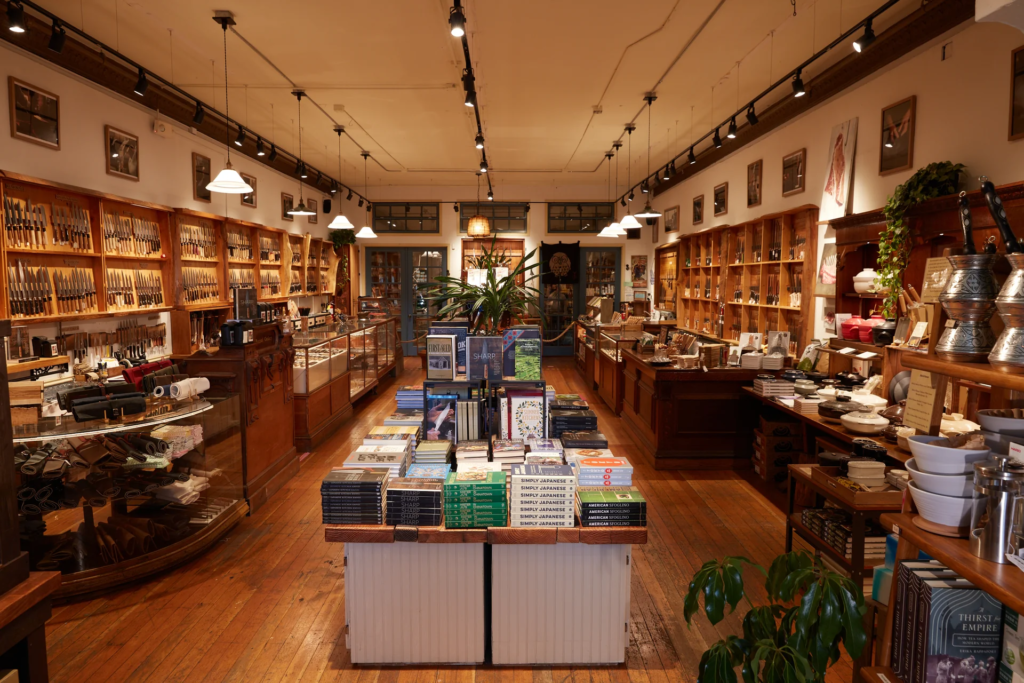
Bernal Cutlery is a full-service cutlery shop that offers sharpening services, Japanese and Western culinary knives, vintage knives, outdoor, pocket, and craft knives, cooking tools and accessories, knife skills and sharpening classes, and more. Established in 2005 by Josh Donald and Kelly Kozak, the shop began by selling vintage and antique culinary knives, and it has since grown to include high-quality new knives sourced from around the world.
Frequently Asked Questions (FAQs):
Are Japanese knives the sharpest?
Japanese knives are certainly among the sharpest knives available in the market due to their high-quality materials and craftsmanship. They are known for their exceptional sharpness and strength, which is why they are highly regarded by chefs and home cooks alike.
What is the most used knife by chefs?
The Global G-2 8-inch chef’s knife is probably the most popular kitchen knife among professional chefs. It features a lightweight, well-balanced design with a comfortable handle that provides excellent control and maneuverability.
What is the world’s sharpest knife?
The world’s sharpest knife is considered to be one with an obsidian blade. However, obsidian is not commonly used for making kitchen knives as it is extremely brittle and coarse.
Conclusion
So, what knife does Joshua Weissman use? He most certainly has a thing for Japanese knives, as most of the knives he owns have originated from there.
Japanese knives are considered one of the best knives because of their precise craftsmanship. The traditional Japanese knife-making process also makes the knives something to cherish.



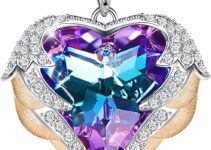

![Espresso Puck Stuck To Grouphead [5 Reasons & Easy Solutions] Espresso Puck Stuck To Grouphead [5 Reasons & Easy Solutions]](https://reviewnery.com/wp-content/uploads/2023/03/espresso-puck-stuck-to-grouphead-211x150.webp)
